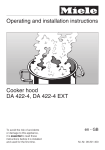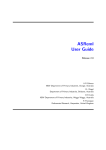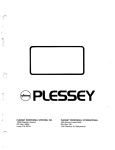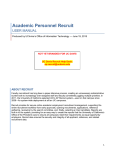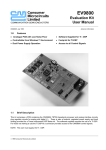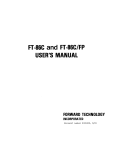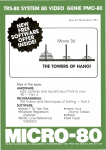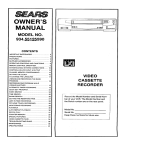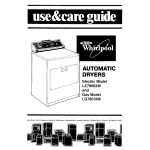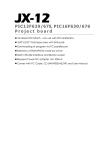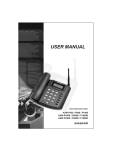Download THE SAFARI EXTRACT GENERATOR EXPERIENCE Michelle Fine
Transcript
DEVELOPING USER APPLICATIONS WITH SASjAF SOFTWARE FOR PCS:
SAFARI EXTRACT GENERATOR EXPERIENCE
THE
Michelle Fine, Aetna Life & Casualty
Abstract
code containing the desired data
selection criteria are linked up
with the Assembler software as well
as the SAFARI masterfile to yield
the requested sub9roups of data.
Preparation of thlS code, however,
is a tedious and time consuming
process. The logic involved can be
complex and there are numerous
coding details to consider.
In
addition, syntax validation is only
available for certain portions of the
code. As a result, coding errors are
easy to make.
In today's changing DP environment,
greater emphasis is being placed,on
providing users with tools allowlng
them to perform functions traditionally handled in a systems department.
As a result, there is a need for software products that facilitate the
development of these end-user,
applications. The screen deslgn
capabilities of the SAS/AF software
for PCs along with its error handling
facilities and dataset manipulation
functions make it a strong candidate
for systems of this nature.
When extract jobs abend as the
result of coding errors, they need
to be- fixed and rerun. SAFARI
processing time is expensive; hence,
reruns are costly.
To help alleviate
this cost and to reduce the time
needed to prepare code files, an
Application Generator was developed
to produce SAFARI extract and dictionary update files.
The Application Generator displays a series
of menu screens and input panels
that prompt the user for necessary
information (e.g. extract criteria,
field names).
It then uses these
parameters to generate the code
needed to run the extract and/or
dictionary update.
This paper addresses a real-life
.
business problem that was solved wlth
SAS/AF software for PCs.
It beg~ns
by presenting a background descrlption of the business environment and
the existing problem.
It then moves
on to outline the stages of system
development highlighting features of
SAS/AF that' were helpful .. The II f~nal
portion of the paper provldes tlPS
and techniques II for using SAS/AF and
offers recommendations for future
development efforts.
Background
The Personal Financial Security
Division of Aetna Life and Casualty
maintains a large database as part
of its SAFARI (System by Aetna for
Fast Access to Records and Information)
system.
Developed in the late 1960 1 s,
this file contains all Personal
Automobile and Homeowners insurance
pOlicy master records - a number
currently in excess of 4 million
records.
SAFARI policy information
is used by different customer areas
to follow business trends, report on
claim activity, and make underwriting
decisions.
Since this file is the
only central source for data of its
type, extracts are commonly required.
The Application Generator was
created on an IBM PC AT using SASjAF
version 6.03.
This product was
chosen due to its reputation for
allowing ease and flexibility in
screen design as well as for providing strong help facility functions.
A personal computer environment was
selected instead of a mainframe
environment due to better response
times and the superior screen design
capabilities offered by the PC
version of the product. The system
was designed to enable both technical
and non-technical users to generate
extract files with the anticipation
that the responsibility for preparing
these files would eventually be
transferred from the systems department to a customer area.
The SAFARI masterfile is a BDAM file
that for purposes of extracting data,
can ~nly be accessed via a series of
Assembler programs.
A IIhomegrown lt
front-end to these programs also
exists to aid in the extract process.
The Assembler front-end is composed
of two parts: An ASI-ST dictionary
of field names that correspond to
several SAFARI masterfile fields:
and Ithomegrown lt code used to select
and sort records, format printed
reports, and update the ASI-ST
dictionary.
Files of I1homegrown ll
Development Experiences
I. Learning the Language
Once SAS/AF had been installed, the
first task in the development process
was to learn seL (~creen fontrol
banguage) - the language that controls the operation of all SAS/AF
1466
of struct ure was very accom modati ng
to the origin al vision for the
system .
PROGRAM screen s. Since no formal
traini ng course s were availa ble, the
User's Manua l became the primar y
educa tional resou rce. For an
experi enced SAS progra mmer, workin g
with SCL requir ed some adjust ment
since both its struct ure and compo sition are notab ly differ ent from
In
those of the base SAS produ ct.
which
ms
progra
SAS
base
to
st
contra
are relati vely unstru ctured and are
proces sed on an interp retive basis,
SCL progra ms have a defin ite structure and need to be compi led prior
to execu tion. While seL does use
many of the base SAS statem ents,
severa l new statem ents and datas et
manip ulatio n functi ons unique to SCL
have also been includ ed.
II.
As antici pated , the facili ties for
creati ng screen s were easy to use and
allowe d a fair amoun t of flexib ility
in terms of the forma t, color, and
size of the screen . SAS/AF provid es
a free-f orm, full-s creen edito r for
use in design ing panel s. Curso r keys
are used to maneu ver and positi on
The
v~rious portio ns of the text.
COLOR comma nd is availa ble to
diver sify the colors used for
differ ent aspec ts of the screen .
The Backg round, Text, Command Line,
and Messa ge areas, among others , can
be modif ied from the defau lts to a
combi nation of up to twelve differ ent
In additi on, the WSHRINK and
colors .
WGRQW comma nds allow both the width
and length of screen s to be altere d.
Once into WSHRINK or WGROW "mode ",
curso r keys are used to reduce and
increa se the size of the panel.
This is helpfu l in situat ions where
multip le panels need to be simul taneously displa yed.
Develo ping the Protot ype
After an initia l period of exper imenta tion with SCL, develo pment of
the protot ype for the Appli cation
Gener ator began. SAFARI extrac t
logic can range from a simple value
check for a single field to more
comple x proce ssing of multip le
The goal of the
occurr ence fields .
protot ype was to produc e a smallscale worka ble system that would
have the same basic forma t as the
projec ted final resul t, but would
only addres s the simpl er cases. The
system could later be expand ed to
includ e more involv ed situat ions.
The protot ype would also includ e
routin es to handle dictio nary update
code gener ation and file upload s to
the mainfr ame since these functi ons
are straig htforw ard in nature as
well.
Anoth er nice featur e of seL is that
it conta ins a series of error contro l
statem ents and variab les which
enable d a PROGRAM screen to mimic a
Coding SAFARI extrac ts
MENU screen .
requir es that five main functi ons be
perfor med. Since some of these
functi ons are compo sed of severa l
sub-fu nction s, keepin g track of
steps compl eted can be confu sing.
The method chosen to ease this
proces s was to initia lly highl ight
each of the five menu option s using
revers e video . Each time a task is
compl eted, the highli ghting is
SAS/AF
remove d from that option .
MENU screen s, howev er, do not allow
menu option s to be highli ghted .
Conse quentl y, a PROGRAM screen was
design ed to look like the desire d
menu and the backg round SCL progra m
incorp orated error statem ents to
contro l the highl ightin g.
SAS/AF proved usefu l in this effor t.
The produ ct prGvid es eight types of
screen s, two of which were the most
benef icial for the Gener ator: MENU
screen s and PROGRAM screen s. MENU
screen s allow the user to choose any
one of a variet y of option s by
enteri ng a corres pondi ng numbe r on
the comma nd line. These screen s have
ll
behin d-the- scene s "attri bute files
lish
estab
which
them
with
assoc iated
relati onshi ps betwee n an option
numbe r and the path of progra ms to
be fOllow ed upon select ion of that
PROGRAM screen s displa y
option .
inform ationa l messa ges and allow the
user to input data value s to the
system . Each PROGRAM screen has an
SCL progra m assoc iated with it that
contro ls valida tion and proce ssing
of the input param eters. This type
Exhib it I shows both the PROGRAM
screen design ed to handle menu
functi ons and the SCL code that
In the INIT
contro ls proce ssing.
sectio n of the progra m, five screen
variab les are initia lized to have
values that corres pond to the five
f~nctions for coding SAFARI extra cts.
'Slnce , by defau lt, seL highl ights
(with revers e video) all screen
variab les that are flagge d with the
ERRORON statem ent as having errors ,
1467
this statement is used to signal SAS
that each of these five variables
is Ilin errorll. The effect of this is
that when the screen is initially
displayed, all five menu options are
highlighted.
Later, in the MAIN
section I each time an option is
selected, the appropriate PROGRAM
or MENU screen is called and the
ERROROFF statement is used to
indicate that the screeh variable
for that option is no longer in
error. Thus, the highlighting is
removed.
functions, in addition to those
previously mentioned, for transferring values between screens.
III.
creating an Expanded Version
The SASjAF software for PCs
accommodated the Application Generator prototype with few difficulties.
Screens created were user-friendly,
response times were fast, and the
SCL programs compiled in relatively
short periods of time. When work
began on the expanded version,
however, some of the drawbacks of
SAS/AF began to surface.
Discussion
of these drawbacks is in no way
intended to discourage development of
SAS/AF systems. However, these are
important facts to consider when
planning potential applications.
The ERRORON and ERROROFF statements
are also helpful for trapping data
values that are input incorrectly.
Screen variables can be edited for
appropriate values and, when an
incorrect entry is found, the
ERRORON statement is used to signal
that the field is in error. The
_MSG_ variable is provided to
communicate messages indicating the
nature of the error. These messages
are displayed in the message area of
the screen.
By default, SCL programs
cannot be exited if any screen
fields are in error. Therefore, the
user is required to reenter correct
values for the specified fields
before processing can continue.
Once this is accomplished, the
ERROROFF statement signals that the
field is no longer in error and
system processing resumes.
The Application Generator prototype
was created on an IBM PC AT that
had 640K RAM.
For purposes of the
prototype, this amount of memory
was sufficient. As the system grew
larger, however, several memory
problems were experienced.
In order
for the system to continue to run, it
was necessary to purchase memory
boards with additional expanded
memory.
1M of memory was needed for
the expanded version to run and an
additional .5M was also purchased to
allow room for future enhancements.
This delayed system development for
six to eight weeks - the time needed
to receive and install the memory
boards.
Two additional features of SCL that
proved useful are its datset manipulation functions and its incorporation of macro variables. SCL
provides a series of functions that
are used to - among other things open, close, sort, retrieve values
from, and update values to SAS
datasets. These functions make
simultaneously accessing multiple
data sets a much easier task than in
the base SAS product. This can be
helpful for processing data located
in several different sources and
for transferring values between
screens. The Application Generator
used this technique to store values
entered on all input panel screens
so that, in the event a screen was
redisplayed prior to completion of
coding an extract, it would reflect
values previously entered. SCL
also provides two macro variable
Problems were also encountered with
several aspects of SCL.
Programs
written in SCL have code size
limitations of 32K. Since the
programs in the prototype were only
designed to handle the simpler extracts, this limit was never reached.
When the programs were expanded to
handle more complex extracts, how-,
ever, several of them exceeded the
size boundaries. To solve this,
the programs were broken down into
multiple, smaller sections and
linked together thru use of the CALL
functions.
In addition, compiling and debugging
seL programs presented some difficulties.
The smaller programs of the
prototype compiled within timeframes
of five to eight minutes. Some of
the larger programs of the expanded
version, however, required as long as
twenty minutes to compile. This
functions - SYMPUT and SYMGET - that
are used to assign and retrieve
values to and from user-defined
macro variables. The Application
Generator took advantage of these
1468
can be viewed and interactively
updated.
Given the powerful dataset
handling capabilities that SAS/AF
makes available l this is desirable.
factor significantly impeded system
development progress.
Debugging SCL
programs can also be difficult.
When a SAS/AF system abends, the
message log does not indicate which
program cau~ed the error.
Instead,
it only specifies the error message
and the values of all variables in
the errant program at the time of
the abend. As a result, if program
variable names are not unique or
easily recognizable, determining the
abending program can involve some
creative detective work.
Conclusion
SAS/AF proved to be a helpful tool
in the development of the Application
Generator.
Despite the drawbacks
encountered, the system was able to
be completed and to function
effectively in the business environment. Consensus is that the decision
to use SASjAF for this project was a
good one.
Had the scope of the
project been less complex, development would certainly have been
easier. However, it was still
possible for the application to meet
all of the originally specified
business needs.
Despite these drawbacks, development
work on the expanded version of the
Application Generator was completed
in June 1989 - approximately one year
after the project had originally
begun. At this writing, the system
is in a pilot phase and reaction has
been positive.
Screens continue to
be user-friendly, response times
ream in sufficiently fast, and the
system has improved productivity by
promoting increased efficiency and
speed in preparing extract files.
The Application Generator is currently scheduled for installation at the
first customer site by year-end 1989.
Exhibit I
INIT:
*****
*****
*****
*****
Tips and Techniques
INITIALIZE SCREEN VARIABLES TO
HAVE VALUES THAT CORRESPOND TO
THE FIVE MAIN FUNCTIONS FOR
CODING SAFARI EXTRACTS.
INITL
'INITIALIZATION';
SCANSEL ~ 'SCAN/SELECTION CRITERIA';
EXTRC ~ 'EXTRACT CARDS';
SORTC = 'SORT CARDS';
DETHDR = 'DETAIL CARDS';
The most important recommendation for
others contemplating projects of this
type is to keep applications as
simple as possible.
The less
complicated the system, the less
likely it will be to require additional memory or to exceed the
limitations for program size.
Smaller applications also have
faster response times and can be
developed more quickly since the SCL
programs compile more rapidly.
In
the event that an application does
become complex, a utility package
such as Norton utilities' liS peed
Disk ll will help to decrease system
processing time.
Speed Di~k will
organize the SCL program catalogs
and SAS data sets in such a way that
accessing them requires only minimal
activity on the part of the readwrite head. Therefore, it takes less
time to access files and less time
for the system to run.
S
='
,;
CONTROL ERROR;
ERRORON INITL SCANSEL EXTRC SORTC
DETHDR;
MSG
I
I;
RETURN;
MAIN:
***** CHECK TO BE SURE OPTION NUMBER
***** ENTERED IS WITHIN THE CORRECT
***** RANGE;
ERROROFF S;
IF (S < '0') OR (S > '5') THEN DO;
MSG
'SELECTION MUST BE A NUMBER
BETWEEN 0 - 5';
ERRORON S;
RETURN;
END;
One other suggestion is to license
the PC SASjFSP product along with
SAS/AF. This package will greatly
aid system development by affording
a means by which dataset observations
1469
DEPENDING ON WHICH OPTION
NUMBER IS SELECTED, CALL
THE APPROPRIATE PROGRAM OR
MENU SCREEN AND REMOVE ERROR
***** HIGHLIGHTING FROM THE OPTION
***** DISPLAY;
*****
*****
*****
*****
IF S = 'I' THEN DO;
CALL DISPLAY('INITLA');
ERROROFF INITL;
MSG
";
S
=
T
';
RETURN;
END:
IF S
'2' THEN DO:
CALL DISPLAY('SCANA');
ERROROFF SCANSEL;
MSG
'
,
S
=
T
';
RETURN;
END:
IF S
'3' THEN DO;
CALL DISPLAY('EXTRA');
ERROROFF EXTRC;
MSG
I
I:
S =
T
Ii
RETURN;
END:
IF S
'4'
THEN DO;
CALL DISPLAY('SRTA');
ERROROFF SORTC;
MSG
1
';
S =
T
';
RETURN;
END:
IF S
'5' THEN DO;
CALL DISPLAY('DETTA.MENU');
ERROROFF DETHDR;
MSG
I
';
S
=
T
I;
RETURN;
END;
IF S
'0' THEN DO;
ERROROFF SORTC DETHDR EXTRC
SCANSEL INITL:
CALL PREVIEW ( 'CLEAR' ) :
RETURN:
END:
RETURN:
TERM:
RETURN:
1470
: DuI L.D~ :0: EF"L{:.,Y {:U TDE>: T. PROGFi{.-'!ii
;Command
(E)
NNi'fl'INf'iNNNNNN!1NNi1NNi'iNNNr;NNNNN!'!r:NNt~Ni'iNNN,\1NNNN,'\: ~
=::.'::::::)
AUTO
1)
(FIEST)
2)
&SCANSEL_ .. _. ___________ ".. _
4}
.s.;SOPTC
5;
&:DETHDF:
0)
E:ETURN TO PREV I DUS MENU
{LAST)
ENTER YOUF: SELECTION:
(PRESS F3 l·j 1 TH TH"J: E; Si=:LECi·· I ON)
J~S
PHESS <ENTER> TO CONTINUE
f~ N 1'1 N N H i1 !,; N i1 N N N N1111!1 N N N NN 11 N N N N N11 NN11 N!1 N N N N11 i'1 Ni"I!1!'1 NN N N N N F; N 1'1 N N N N ,I>i N N N N11 NN N i't N N r!:=::1
1471
feN t.! r: r· N N <"






